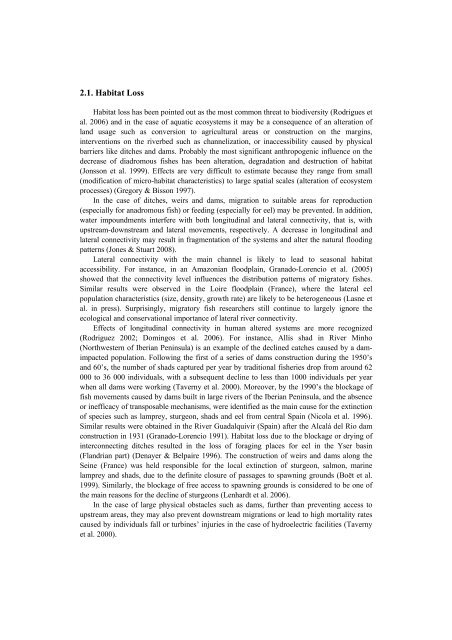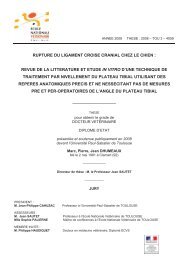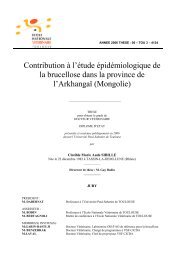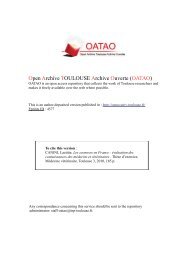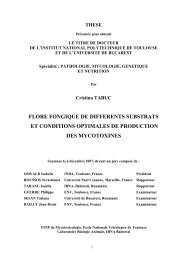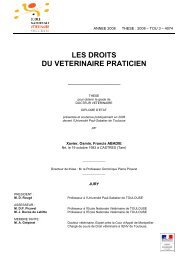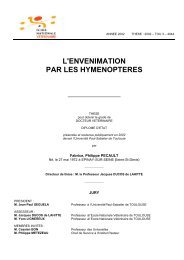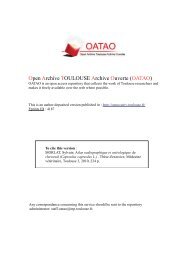PDF ( Author's version) - OATAO (Open Archive Toulouse Archive ...
PDF ( Author's version) - OATAO (Open Archive Toulouse Archive ...
PDF ( Author's version) - OATAO (Open Archive Toulouse Archive ...
You also want an ePaper? Increase the reach of your titles
YUMPU automatically turns print PDFs into web optimized ePapers that Google loves.
2.1. Habitat Loss<br />
Habitat loss has been pointed out as the most common threat to biodiversity (Rodrigues et<br />
al. 2006) and in the case of aquatic ecosystems it may be a consequence of an alteration of<br />
land usage such as con<strong>version</strong> to agricultural areas or construction on the margins,<br />
interventions on the riverbed such as channelization, or inaccessibility caused by physical<br />
barriers like ditches and dams. Probably the most significant anthropogenic influence on the<br />
decrease of diadromous fishes has been alteration, degradation and destruction of habitat<br />
(Jonsson et al. 1999). Effects are very difficult to estimate because they range from small<br />
(modification of micro-habitat characteristics) to large spatial scales (alteration of ecosystem<br />
processes) (Gregory & Bisson 1997).<br />
In the case of ditches, weirs and dams, migration to suitable areas for reproduction<br />
(especially for anadromous fish) or feeding (especially for eel) may be prevented. In addition,<br />
water impoundments interfere with both longitudinal and lateral connectivity, that is, with<br />
upstream-downstream and lateral movements, respectively. A decrease in longitudinal and<br />
lateral connectivity may result in fragmentation of the systems and alter the natural flooding<br />
patterns (Jones & Stuart 2008).<br />
Lateral connectivity with the main channel is likely to lead to seasonal habitat<br />
accessibility. For instance, in an Amazonian floodplain, Granado-Lorencio et al. (2005)<br />
showed that the connectivity level influences the distribution patterns of migratory fishes.<br />
Similar results were observed in the Loire floodplain (France), where the lateral eel<br />
population characteristics (size, density, growth rate) are likely to be heterogeneous (Lasne et<br />
al. in press). Surprisingly, migratory fish researchers still continue to largely ignore the<br />
ecological and conservational importance of lateral river connectivity.<br />
Effects of longitudinal connectivity in human altered systems are more recognized<br />
(Rodriguez 2002; Domingos et al. 2006). For instance, Allis shad in River Minho<br />
(Northwestern of Iberian Peninsula) is an example of the declined catches caused by a damimpacted<br />
population. Following the first of a series of dams construction during the 1950’s<br />
and 60’s, the number of shads captured per year by traditional fisheries drop from around 62<br />
000 to 36 000 individuals, with a subsequent decline to less than 1000 individuals per year<br />
when all dams were working (Taverny et al. 2000). Moreover, by the 1990’s the blockage of<br />
fish movements caused by dams built in large rivers of the Iberian Peninsula, and the absence<br />
or inefficacy of transposable mechanisms, were identified as the main cause for the extinction<br />
of species such as lamprey, sturgeon, shads and eel from central Spain (Nicola et al. 1996).<br />
Similar results were obtained in the River Guadalquivir (Spain) after the Alcalá del Rio dam<br />
construction in 1931 (Granado-Lorencio 1991). Habitat loss due to the blockage or drying of<br />
interconnecting ditches resulted in the loss of foraging places for eel in the Yser basin<br />
(Flandrian part) (Denayer & Belpaire 1996). The construction of weirs and dams along the<br />
Seine (France) was held responsible for the local extinction of sturgeon, salmon, marine<br />
lamprey and shads, due to the definite closure of passages to spawning grounds (Boët et al.<br />
1999). Similarly, the blockage of free access to spawning grounds is considered to be one of<br />
the main reasons for the decline of sturgeons (Lenhardt et al. 2006).<br />
In the case of large physical obstacles such as dams, further than preventing access to<br />
upstream areas, they may also prevent downstream migrations or lead to high mortality rates<br />
caused by individuals fall or turbines’ injuries in the case of hydroelectric facilities (Taverny<br />
et al. 2000).


